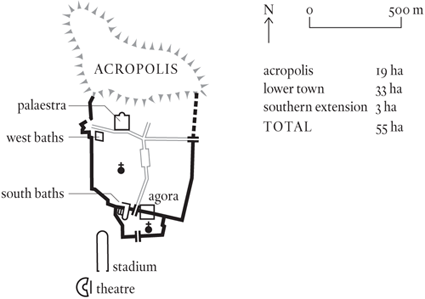
Deserted site near Aksu, Antalya province, south-west Turkey
Capital of the late Roman province of Pamphylia
Perge was one of the half-dozen settlements planted by the Greeks on the Pamphylian (south Turkish) coast during the period immediately following the Trojan War (c. 1100 BC). Presumably it started out as a citadel, perched on the hilltop behind the classical town. In the seventh century BC the settlers were reinforced by a Peloponnesian contingent, but Perge attracted little attention before the Hellenistic period when it became prosperous enough to relocate to the foot of the hill. This lower town was protected by a fine set of walls that enclosed a rectangular area, thirty-three hectares in extent. Curiously, no trace of this or any other circuit has been found on the acropolis, but the archaeological investigation of Perge is still in its early days and there can be no doubt about the hill being fortified. It would have been unthinkable for Perge’s citizens to have allowed themselves to be overlooked by an undefended hill, and cisterns atop that hill testify to the city being prepared to hold out at that place.

In the Roman period, Perge did well. A fine palaestra (open-air gymnasium) was erected in the north-west quarter of the town during the reign of Claudius (AD 41–54), and in the Severan era (193–211) a grandiose set of public baths went up outside the south gate. Concurrently the city wall immediately to the east of this gate was torn down to make room for a new agora. A new wall was then built to bring both the agora and the baths within the city. This increased the area of the lower town from thirty-three to thirty-six hectares, a figure we can translate into a population of 4,000 to 5,000.
In the early empire, Perge vied with its near neighbour SIDE for the title of first city of Pamphylia. Eventually the issue was decided in Perge’s favour, for when Pamphylia was raised to provincial rank (by Diocletian in AD 297) Perge became the residence of the governor. From this time on there is no doubt that it was the more important of the two. It also seems to have lasted longer, for although the lower town was abandoned in the late Roman period, the acropolis provided a refuge for the more steadfast inhabitants. This remnant held out for a period that can only be guessed at but may have lasted until the eleventh century when Attaleia, modern Antalya, emerged as the leading town of the region.
Perge is well worth a visit. The theatre and the stadium, both situated on the southern approach to the city, make a fine pair of monuments, better preserved than most, and the walls and the original south gate are interesting specimens of Hellenistic military architecture. But there should be more to see than there is. The city’s famous Temple of Pergaean Artemis (a variant of the Anatolian mother goddess) hasn’t yet been clearly located, and the town plan needs elucidating. It is hoped that the site will soon be adopted by an institution capable of sustaining a long-term programme of excavation.